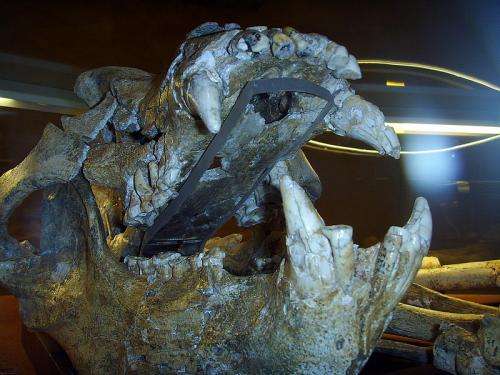September 10, 2013 report
Researchers reconstruct mitochondrial genome of Middle Pleistocene cave bear

(Phys.org) —Researchers have reconstructed the mitochondrial genome of a Middle Pleistocene cave bear using a bone sample found in Spain. This is the first time anyone has reconstructed such an old genome from a sample found outside the tundra. To reproduce the genome, Matthias Meyer of the Max Planck Institute for Evolutionary Anthropology in Leipzig and his team devised a new technique for stringing together small DNA strands. In addition to recreating the genome, the team were able to reconstruct the cave bear's phylogeny. The research appears in the Proceedings of the National Academy of Sciences.
DNA fragments over time, largely because of depurination, making it hard to analyze very old samples. The fragmentation rate is temperature-based; DNA from samples recovered from permafrost tends to be less fragmented than DNA from samples found elsewhere. Recently, for example, scientists were able to reconstruct the genome of an approximately 700,000 year old horse from a sample in Canada's Yukon Territory. Until now, however, scientists have only been able to generate sequences from non-permafrost samples about 120,000 years old or younger.
Meyer and his colleagues studied a bone sample from a Middle Pleistocene cave bear (Ursus deningeri). The sample, found at Spain's Sima de los Huesos cave site, was more than 300,000 years old. The researchers believed they could recreate the cave bear's genome by improving the method of DNA extraction.
As DNA samples age, intact sequences become smaller. However, DNA library purification techniques tend to cause the loss of DNA molecules less than 40 bp. To preserve smaller molecules, the team used a single-stranded DNA preparation method used recently in the sequencing of Neanderthal and Denisovan genomes. This method eliminates these purification steps. By combining this single-stranded method with a widely used silica-based DNA extraction technique, the researchers were able to recover and sequence DNA molecules as short as 30 bp.
Meyer's team were able to construct a phylogeny of cave bears, determining that Ursus deningeri diverged from the common ancestor of the Late Pleistocene cave bears Ursus spelaeus and Ursus ingressus at an early stage, to form a sister lineage.
The researchers say it may be possible to sequence DNA molecules even shorter than 30 bp in the future. This will allow geneticists to reconstruct even more Middle Pleistocene genomes, including those from hominin samples at the Sima Los Huesos site, which contains the largest collection of Middle Pleistocene hominin fossils in the world.
More information: Complete mitochondrial genome sequence of a Middle Pleistocene cave bear reconstructed from ultrashort DNA fragments, PNAS, Published online before print September 9, 2013, DOI: 10.1073/pnas.1314445110
Abstract
Although an inverse relationship is expected in ancient DNA samples between the number of surviving DNA fragments and their length, ancient DNA sequencing libraries are strikingly deficient in molecules shorter than 40 bp. We find that a loss of short molecules can occur during DNA extraction and present an improved silica-based extraction protocol that enables their efficient retrieval. In combination with single-stranded DNA library preparation, this method enabled us to reconstruct the mitochondrial genome sequence from a Middle Pleistocene cave bear (Ursus deningeri) bone excavated at Sima de los Huesos in the Sierra de Atapuerca, Spain. Phylogenetic reconstructions indicate that the U. deningeri sequence forms an early diverging sister lineage to all Western European Late Pleistocene cave bears. Our results prove that authentic ancient DNA can be preserved for hundreds of thousand years outside of permafrost. Moreover, the techniques presented enable the retrieval of phylogenetically informative sequences from samples in which virtually all DNA is diminished to fragments shorter than 50 bp.
Journal information: Proceedings of the National Academy of Sciences
© 2013 Phys.org

















